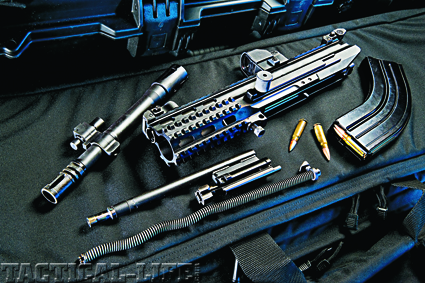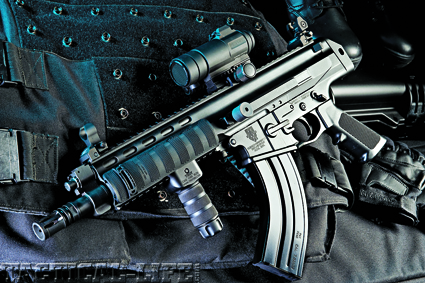XCR Micro available in 5.56 NATO, 6.8 SPC and 7.62x39mm; O/A LENGTH: 27.25” with 9” barrel
From the backyard inventor to the mechanical engineers of MIT, the path toward innovation is the same: How can we make it better, what new materials can we use, and can we take it a step further? Resourceful curiosity has been in the heart of every American innovator from Edison to Ford. Applied to modern weapons designs, this same spirit paired with a relentless attention to detail has borne fruit along Utah’s Wasatch Front, to produce the Robinson Arms Company’s XCR Modular Weapon System.
Company founder and President Alex Robinson’s design philosophy centers around what he calls the “Five Fundamental Design Factors:” Ergonomics, Reliability, Durability, Modularity, and Accuracy. It is to this mantra he returns as he guides the evolution of what he refers to as his “Kalashnikov Theory” weapon systems.
Advertisement — Continue Reading Below
The XCR’s core strength lies in its upper receiver design. It is the foundation upon which several calibers, a variety of barrel lengths (7 to 18 inches), and multiple platforms (Standard, Mini, Micro and Micro Pistol) are configured. The innate reliability of the components within the receiver is a function of the linear and adjustable gas-piston action, whose guides are extruded directly into the proprietary aircraft aluminum receiver and operate without bolt-on rails that can bend, loosen or require replacement. This fundamentally simpler configuration both aligns and manages the gas piston, resulting in a solid, centered action. John Farnam, noted author and tactical firearms instructor comments, “The XCR brings together several very functional design elements in that the gas-piston, operating rod and bolt carrier are all one piece. This prevents the parts from constantly slamming around and ultimately makes the rifle much more reliable.”
Operator Friendly

The interchangeable parts required to switch the XCR to 7.62x39mm. The “Kalashnikov-theory” influences bring battle-tested design features to the XCR’s operating system. Note the adjustable gas feature attached to the barrel.
The same functional, common-sense design approach also led Robinson to place a non-reciprocating charging handle on the left side of the upper receiver, rather than below the rear sight post. A right-handed operator’s right hand never has to leave the trigger housing and his left can manipulate the bolt and return to a functional, tactical hand position in much less time than the cross-overs required by a typical AR design. Additionally, the knob of the charging handle functions as a forward assist, again eliminating the need for the operator to radically change hand and rifle positions when changing magazines or clearing the action.
Advertisement — Continue Reading Below























